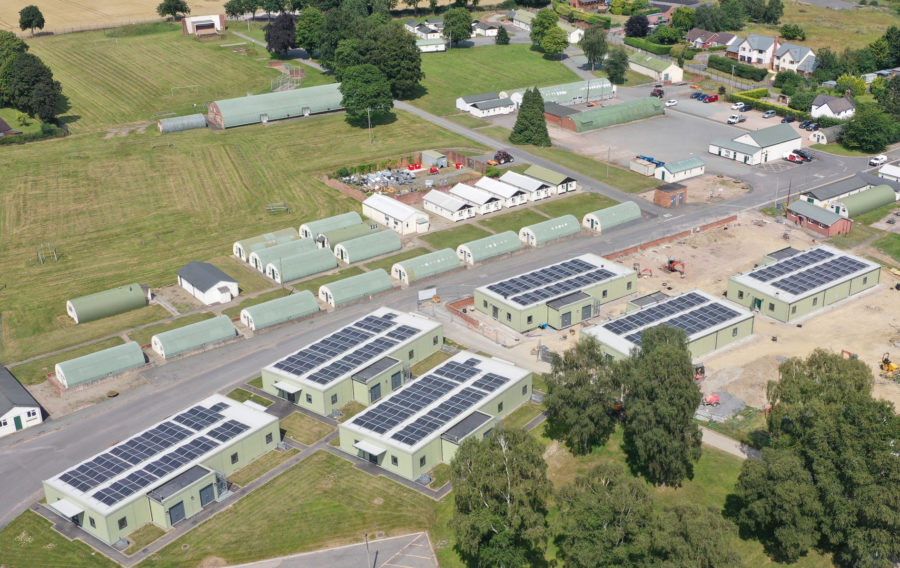
Landmarc Support Services (Landmarc) works in partnership with the Defence Infrastructure Organisation (DIO) to provide the support services that enable our Armed Forces to live, work and train on the MOD’s UK Defence Training Estate (DTE). For the second consecutive year, this partnership has managed a record twelve months of programme delivery on the DTE. Writing for Defence Online, Peter Nicol, Programme Director at Landmarc, reflects on a year of significant development and investment on the Training Estate.
The 2020/21 financial year (FY) had already been Landmarc and DIO’s busiest year to date, yet last year continued to see a huge investment in the MOD’s 190,000 hectare built and rural military training estate. Improving facilities for training troops with a substantial £85m valued investment – an impressive 68 per cent increase on the £50m spent in the previous year.
NetCAP
The Net-Zero Carbon Accommodation Programme (NetCAP) has dominated programme delivery over the last two years, part of which saw a Fiscal Stimulus inject of £38m spanning an 18 month period to the end of FY 21/22.
This project is a critical contribution to the government’s target to achieve net-zero emissions by 2050, while also improving the lived experience of our Armed Forces while they use the DTE to train.
Working with DIO and offsite construction specialist, Reds10, an unprecedented 31 carbon-negative buildings were installed across seven locations during FY 2021/22, all completed on time and to budget. This included the Estate’s first double-storey accommodation at Brunswick Camp in the Southeast, which encompasses additional environmental measures such as rainwater harvesting.
The use of Modern Methods of Construction (MMC) also helped to deliver the DTE’s first Combined Joint Operations Cell (CJOC) at Wretham Camp, part of an initiative to provide a centre of excellence for Mission Specific Training at Stanford Training Area.
The programme was cited as an example of best practice at COP26 and has won a number of industry awards including the Government Opportunities Public Procurement Award for ‘Infrastructure Project of the Year’, the MOD Sanctuary Award for ‘Net Zero and Resource Efficiency’ and a number of modular construction industry awards through Landmarc’s supply chain partner, Reds10.
This year, a further 35 NetCAP buildings are scheduled for delivery, providing more than 3,900 new bed spaces and saving an impressive 9,100 tonnes of carbon.
Supporting mission-critical training
In the Scotland and Northern Ireland region, troops are benefitting from a new 800m2 twelve-bay armoury and eight-bay magazine complex, which will significantly improve the security of weapons and ammunition storage for live-fire training.
Delivered in just 10 months, this project provides a modern, self-contained facility for the separate storage of weapons and ammunition that complies with the Dangerous Substances and Explosives Atmospheres Regulations (DSEAR) and all relevant JSPs.
A new range tower at Castlemartin is also a critical addition to providing live firing capabilities for the next generation of Armoured Fighting Vehicles (AFVs) in the Wales and West regions over the next coming years, supporting advancements in communication technologies and sighting systems, as well as providing a larger viewing area so that ‘safe place’ can be monitored more effectively.
Any lessons identified via user feedback or from the construction process are being incorporated into designs and planning for future towers, with the next scheduled for delivery later this year.
Rural estate
The preservation of the DTE’s rural estate is also a key responsibility for the team.
Last year the company delivered over £1.5m of work through the Conservation Stewardship Fund and SSSI Funds to improve and preserve the natural and historic environment of the estate.
In particular, Landmarc proudly continues to lead the way in the management of woodland in the wake of climate change and disease.
Significant felling programmes have taken place on trees infected with Ash Dieback disease across Catterick Training Area and Salisbury Plain to protect the future of UK woodland, both with highly successful results.
While both rural and built estate teams have also had to deal with the aftermath of 2021’s winter storms, which saw vast areas of the Defence Training Estate sustain a massive amount of damage.
Landmarc rural teams have carried out just under £1m worth of forestry reinvestment works such as planting, weeding and establishment, rhododendron clearance and track repairs, and have completed initial surveys for new woodland creation projects.
Safety first
One of Landmarc’s most recent projects from FY 2021/22 is the installation of a new pedestrian footbridge between Knook’s North and South Camps on Salisbury Plain.
The road between the north and south camps is busy so can be dangerous to both pedestrians and road users at times.
With safety always a number one priority, the bridge works create a safer pedestrian environment to protect all users from oncoming traffic.
The project has provided a safe method of transit, allowing estate users to fully utilise both sides of the camp and the training areas on the north side of the Plain.
Regional highlights
In addition to the above headline projects, the regional teams have delivered over 900 tasks with the aim of improving camp facilities across the UK.
Examples include re-opening Woodbury Common Grenade Range, multiple accommodation projects and target system upgrades.
The Army has also funded significant work to improve tenanted accommodation across all areas of the estate.
Despite commercial challenges and economic changes over recent years, Landmarc and DIO have achieved a record twelve months for programme delivery on the DTE, for the second year running.
With camp improvement very much on the agenda for FY 2022/23, it’s looking to be yet another successful year of programme delivery for the Training Estate.
If you would like to join our community and read more articles like this then please click here.
Defence Infrastructure Organisation Defence Training Estate DIO DT&E Landmarc Ministry of Defence







